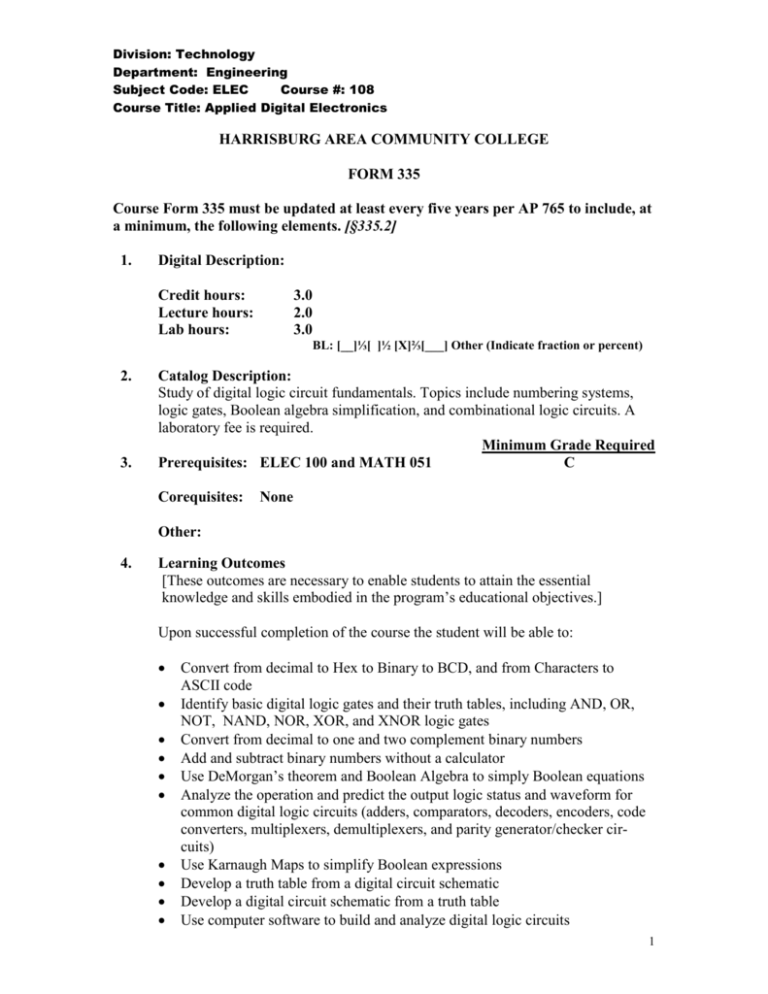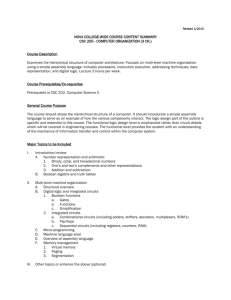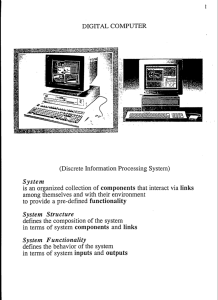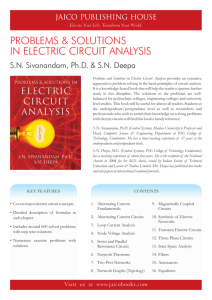FORM 335 - Harrisburg Area Community College
advertisement

Division: Technology Department: Engineering Subject Code: ELEC Course #: 108 Course Title: Applied Digital Electronics HARRISBURG AREA COMMUNITY COLLEGE FORM 335 Course Form 335 must be updated at least every five years per AP 765 to include, at a minimum, the following elements. [§335.2] 1. Digital Description: Credit hours: Lecture hours: Lab hours: 3.0 2.0 3.0 BL: [__]⅓[ ]½ [X]⅔[___] Other (Indicate fraction or percent) 2. 3. Catalog Description: Study of digital logic circuit fundamentals. Topics include numbering systems, logic gates, Boolean algebra simplification, and combinational logic circuits. A laboratory fee is required. Minimum Grade Required Prerequisites: ELEC 100 and MATH 051 C Corequisites: None Other: 4. Learning Outcomes [These outcomes are necessary to enable students to attain the essential knowledge and skills embodied in the program’s educational objectives.] Upon successful completion of the course the student will be able to: Convert from decimal to Hex to Binary to BCD, and from Characters to ASCII code Identify basic digital logic gates and their truth tables, including AND, OR, NOT, NAND, NOR, XOR, and XNOR logic gates Convert from decimal to one and two complement binary numbers Add and subtract binary numbers without a calculator Use DeMorgan’s theorem and Boolean Algebra to simply Boolean equations Analyze the operation and predict the output logic status and waveform for common digital logic circuits (adders, comparators, decoders, encoders, code converters, multiplexers, demultiplexers, and parity generator/checker circuits) Use Karnaugh Maps to simplify Boolean expressions Develop a truth table from a digital circuit schematic Develop a digital circuit schematic from a truth table Use computer software to build and analyze digital logic circuits 1 Division: Technology Department: Engineering Subject Code: ELEC Course #: 108 Course Title: Applied Digital Electronics 5. Interpret digital logic schematic diagrams Use test equipment to trouble shoot digital circuits; i.e., logic probes, logic analyzer, oscilloscope Build digital logic circuits given a schematic Perform trouble-shooting of digital logic circuits Prepare, organize and write formal laboratory reports Apply scientific methods while performing laboratory experiments Analyze circuits using circuit simulation software such as Circuit Maker, Multisim or Pspice Program CPLD devices and interface them with other digital logic devices and circuits Planned Sequence of Learning Activities [These must be designed to help students achieve the learning outcomes.] A. Numbering Systems 1. Hex 2. BCD 3. Standard Binary numbers 4. Binary (ones and twos complement) 5. ASCII code B. Logic Circuits 1. Basic Logic Gates 2. Schematic Symbols 3. Boolean Algebra and Truth Tables 4. Building logic circuits and identifying schematic notation C. Test Equipment 1. Logic probe 2. Function generators 3. Digital Logic Trainers 4. Digital Circuit Simulation Software 5. Digital Logic Analyzers 6. Digital Storage Oscilloscopes D. Boolean Alegbra and Logic Simplification 1. Boolean operations and expressions 2. DeMorgan’s Theorem 3. Boolean simplification 4. SOP and POS standard equations 5. Use of equation simplification software 6. Use Karnaugh Maps to simplify Boolean equations 2 Division: Technology Department: Engineering Subject Code: ELEC Course #: 108 Course Title: Applied Digital Electronics E. Use of combinational logic circuits 1. Universal NAND and NOR circuits 2. AND-OR-Invert circuits F. Combinational Logic circuits 1. adders 2. comparators 3. decoders 4. encoders 5. code converters 6. multiplexers 7. demultiplexers 8. parity generators/checkers G. Testing and Troubleshooting logic circuits H. 1. CPLD programming software 2. CPLD interfacing 6. Assessment of Student Learning [Methods of assessment should be appropriate for Learning Outcomes listed above.] Assessment of student learning outcomes for the course, as required by AP 765, is part of regular curriculum maintenance and/or improvement. The specific plan has been determined by the pertinent faculty involved and is kept on file in the division office. 1. Exam – Decimal and Character Conversions 2. Exam – Digital Logic Gates and Truth Tables 3. Exam – Binary Numbers 4. Exam – Addition and Subtraction of Binary Numbers 5. Exam – DeMorgan’s Theorem and Boolean Algebra 6. Exam – Operation of Common Digital Logic Circuits 7. Exam – Karnaugh Maps 8. Exam – Truth Tables from Digital Circuit Schematic 9. Exam – Digital Circuit Schematic from a Truth Table 10. Lab – Build and Analyze Digital Logic Circuits 11. Lab – Interpret Digital Schematic Diagrams 12. Lab – Troubleshoot Digital Circuits 13. Lab – Build Digital Logic Circuits Given a Schematic 14. Lab – Perform Troubleshooting of Digital Logic Circuits 15. Lab – Create Formal Laboratory Reports 16. Lab – Applying Scientific Methods 17. Lab – Analyze Using Circuit Simulation Software 18. Lab – Program CPLD Devices 3 Division: Technology Department: Engineering Subject Code: ELEC Course #: 108 Course Title: Applied Digital Electronics 7. List of Texts, References, Selected Library Resources or other Learning Materials (code each item based on instructional use): C-Lecture/Laboratory, A-Lecture, B-Laboratory, LC-Lecture/Clinical, CLN-Clinical, I-Online, BL-Blended, D-Independent Study, P-Private Lessons, E-Internship, F-Cooperative Work-Study, FE-Field Experience. [These resources must be easily accessible to students.] C, BL – Digital Fundamentals with PLD Programming, Floyd, 1st Edition, Prentice Hall (ISBN 0131701886) 8. Prepared by Faculty Member: Earl C. Myers/Bill Forney Date: 4/8/11 9. Approved by Department Chairperson: Date: 10. Approved by Academic Division Dean: Virgil C. Ganescu Date: 5/2/11 This course meets all reimbursement requirements of Chapter 335, subchapters A / B. This course was developed, approved, and offered in accordance with the policies, standards, guidelines, and practices established by the College. It is consistent with the college mission. If the course described here is a transfer course, it is comparable to similar courses generally accepted for transfer to accredited four-year colleges and universities. 11. Director, Curriculum Compliance: Erika Steenland (Interim) Date: 8/24/11 12. Provost & VP, Academic Affairs: Ronald R. Young Date: 8/24/11 13. Original Date of course approval by the college: 199930 14. Date(s) of subsequent reviews [Indicate change: Learning Outcomes; textbook(s)]: 12/01/01 09/29/03 09/16/04 10/21/05 11/20/07 09/15/08 – Catalog Description; Type of Instruction; Learning Outcomes; Assessment of Student Learning 3/15/10 – Type of Instruction 04/08/11- Updated co requisite 12/1/04 Review and updated: 10/26/07; 1/11/08; 1/16/09; 7/14/09 4




